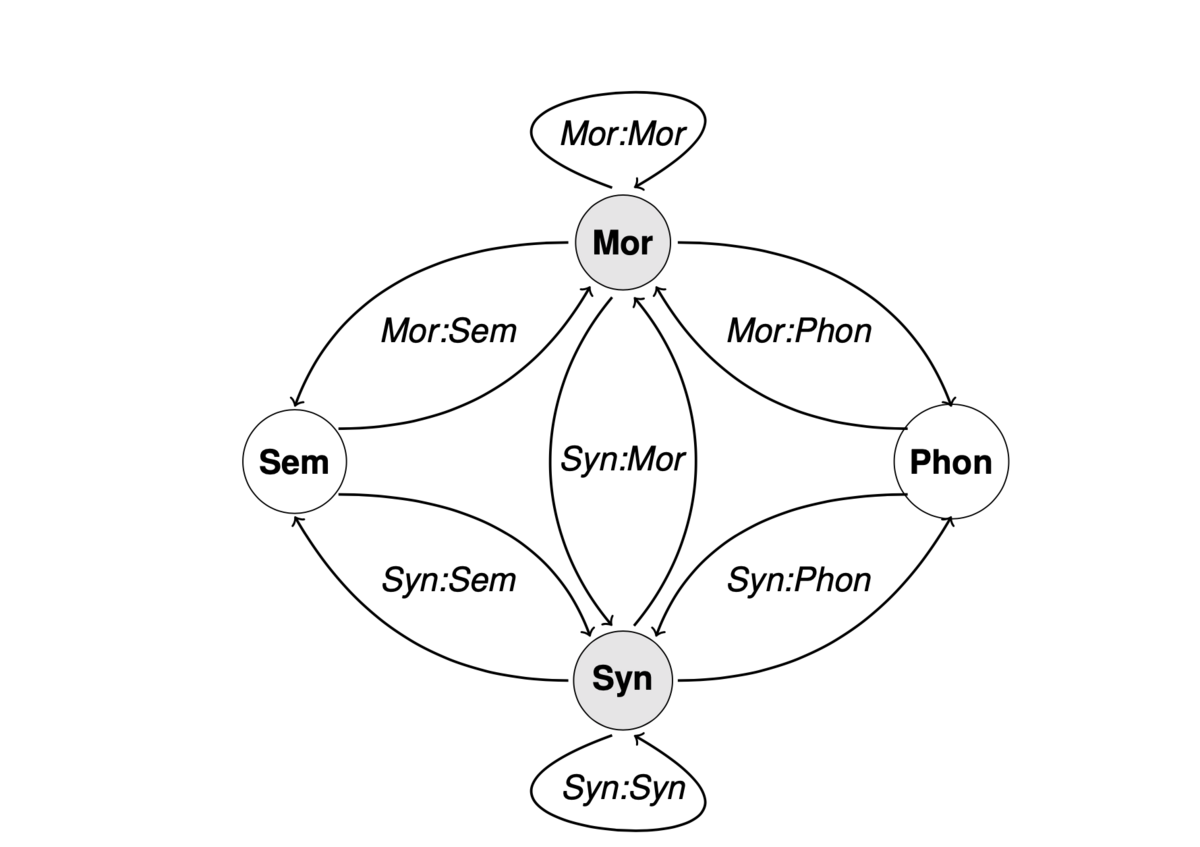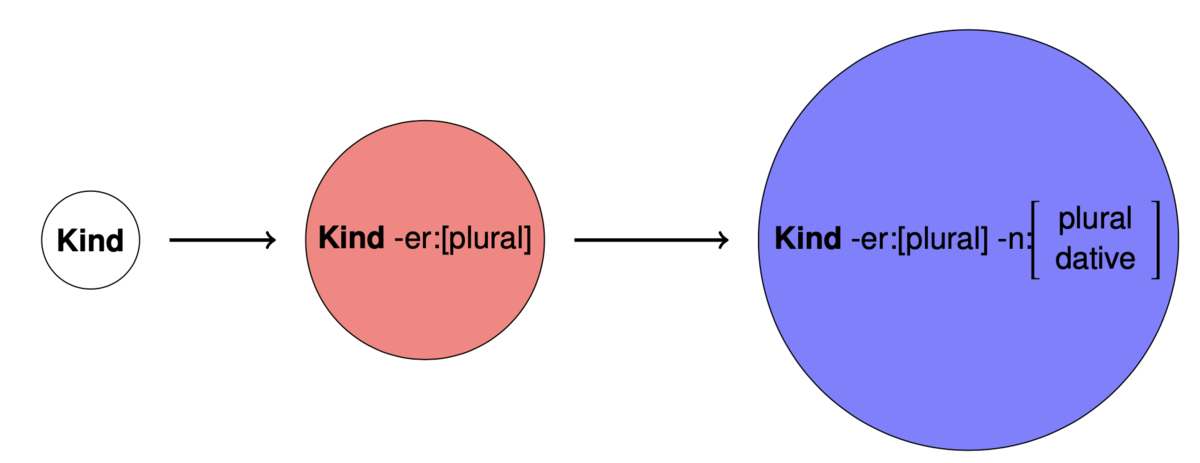This page provides information on the subprojects and central concepts of the DFG Research Unit on Cyclic Optimization, (FOR 5175), which will start on October 1st, 2021.
Cyclic structure building and optimization are two central research areas of grammatical theory, but also closely related to core concepts in psychology and computation: Cyclicity implements the intuition that problem solving is not global, but applies in small incremental steps. Optimization approaches allow for bridging the gap between computational models of neural neural networks in Cognitive Science and symbolic models of human language.
This research unit explores the hypothesis that combining cyclicity and optimization achieves an added level of explanation not available to either alone: Cyclicity can substantially restrict the search space of optimization processes and explain why optimization is often surface-opaque, while optimization yields a principled account for the timing, size, and variability of cycles.
Subprojects
- Principal Investigator: Prof. Gereon Müller
Website of the project
This project pursues a strictly derivational, cyclic, optimization-based approach to inflectional morphology that offers new perspectives on phenomena like affix order, extended exponence, disjunctive blocking, apparently non-local stem allomorphy, and *ABA patterns; beyond that it will primarily be investigated for recalcitrant concepts like impoverishment, exponent drop, deponency, paradigmatic gaps, morphological movement, discontinuous bleeding, and learning algorithms for underspecification.
- Principal Investigators: Prof. Jochen Trommer & Dr. Eva Zimmermann
Website of the project
This projects explores a novel cyclic optimization theory that explains recurring problems in the morpho-phonology of tone.
- Principal Investigators: Prof. Barbara Stiebels & Prof. Jochen Trommer
Website of the project
This subproject studies the role of Phonology and Semantics for the linearization of affixes.
- Principal Investigator: Jun.Prof. Maria Kouneli
Website of the project
The goal of this project is to investigate grammatical number in the nominal and verbal domain of Eastern Sudanic languages, and to investigate whether a cyclic optimization approach is better-suited to account for the attested cross-linguistic variation.
- Principal Investigator: Prof. Fabian Heck
Website of the project
The project investigates the empirical and formal properties of repair phenomena in syntax that can be characterized as "last resort" operations.
- Principal Investigator: Dr. Philipp Weisser
Website of the project
The topic of this project is dislocation of clausal and phrasal coordinators, i.e., elements such as 'and', 'or', or 'but' which do not surface in the linear position in between the two coordinands they connect but rather inside one of their conjuncts. The goal of this project is to investigate the consequences of this process for theories of clitic placement and the syntax-prosody interface.
- Principal Investigator: Prof. Barbara Stiebels
Website of the project
The project studies the linguistic means to improve the match between clause-embedding predicates and their clausal complements (e.g. by semantic enrichment of the complement clause or coercion/semantic shift of the clause-embedding predicate).
- Principal Investigator: Prof. Gregory Kobele
Website of the project
What is cyclic optimization? What distinguishes it empirically from theories employing other mechanisms? How could the human sentence processing mechanism work, if based on a cyclically optimizing grammar?
Central concepts of the Research Unit
The intuition behind cyclic models of grammars is that the same operations (or types of operations) apply iteratively in increasingly bigger morphosyntactic domains. A simple version of this idea is interleaving syntactic or morphological structure-building operations with interpretive or restructuring operations. Thus, in Chomsky’s Minimalist Syntax, the basic operation Merge is structure-building in creating hierarchical syntactic representations ("trees") whereas the alternating operation Agree just modifies the featural content of syntactic units, or, under a slightly different perspective, adds information for morphological interpretation. Similarly in Lexical Phonology and Stratal Optimality Theory, phonological rules are cyclically interleaved with morphological structure building. Cyclicity, although often not under this label, is found in a broad array of theoretical work, for example also in different versions of Construction Grammar, and classical grammar formalisms which apply compositional semantics to syntactic representations based on phrase structure grammar or Categorial Grammar.
Optimization is a grammatical procedure which chooses among different potential alternatives and blocks suboptimal alternatives, based on a structured set of criteria. A classical case is the Elsewhere Condition, which captures, for example, the fact that more specific morphological realizations block more general ones, such as the blocking of the potential English plural forms *ox-es by the listed form ox-en. Optimization in the broad sense envisaged here underlies not only Optimality Theory and Harmonic Grammar, but also psycholinguistic race models, analogy-based models, and last-resort and repair operations in derivational approaches to syntax.
A standard intuition in formal models of morphology is that a specific word form like the German dative plural Kind-er-n 'to children' is computed by choosing affixes which optimize the realization of inflectional features. This explains directly why this form is not just realized as Kind-er, where the dative feature remains unrealized. Cyclicity is a simple means to capture affix order in this form, for example by the assumption that -er is an inner/stem-forming, and -n an outer/word-level affix, and are attached to the root Kind in this order:
Both models alone do not explain why the apparently superfluous plural -er must be used in addition to dative plural -n. However, combining both cyclicity and optimization, we may assume that optimization applies in cycles. In the inner (stem) cycle only -er is available, and adding it realizes a dative plural input better (although not perfectly) than the bare root. In the outer cycle, adding also -en allows for realizing even more of the input features. That the previously added -er cannot be removed at that step follows then from another standard assumption of cyclic theories that effects of earlier cycles are immune to later modification.
Cyclic Optimization is currently investigated in three different lines of research:
First, approaches combining standard OT-optimization with elements of rule-based Lexical Phonology assuming qualitatively different phonological subgrammars that are cyclically interleaved with morphosyntactic levels of increasing size such as Stem, Word and Phrase (Kiparsky 2000, 2015, Bermúdez-Otero 2012, Rubach 2003). Cyclic Optimization also underlies the major formalizations of Construction Phonology (Orgun 1996, Inkelas 2014) and Morphology (Inkelas & Caballero 2013).
Second, a version of CO has independently been developed in derivational approaches to cyclic effects in syntax based on the insight that there is a parametric language-specific choice between Merge and Agree operations at a given derivational step in Minimalist grammars, which can be naturally captured by violable constraints (Müller 2009). Integrating cyclicity and optimization is also suggested by the growing evidence that one of the central mechanism of derivational minimalism, establishing a phase, does not apply deterministically in derivations, but can be delayed resulting in "dynamic" phases (Bobaljik & Wurmbrand 2005, den Dikken 2007, Boškovic 2014, Harwood 2015).
The third and most recent line of research leading to CO is work in iterative optimization approaches especially Harmonic Serialism (HS) and Optimality Theory with Candidate Chains (OT-CC), which inherently employ a kind of porto-cyclicity: operations of different types are iteratively interleaved. Under the natural assumption that a single serial OT-grammar optimizes both morphosyntax and phonology, HS inherently instantiates a full-fledged cyclic model of grammar. A version of OT-CC which makes this explicit is th
Representative research in Leipzig related to Cyclicity and Optimization
- Müller, G. 2020. Inflectional morphology in Harmonic Serialism. London: Equinox.
- Trommer, J. & S. Bank. 2017. Inflectional learning as local optimization. Morphology 27. 383–422.
- Heck, F. & G. Müller. 2016. On accelerating and decelerating movement. From Minimalist preference principles to Harmonic Serialism. In G. Legendre, M. Putnam, H. de Swart & E. Zaroukian (eds.), Optimality-theoretic syntax, semantics, and pragmatics, 78–110. Oxford University Press.
- Trommer, J. 2013. Stress uniformity in Albanian: morphological arguments for cyclicity. Linguistic Inquiry 44(1). 109–143.
- Zimmermann, E. 2020. Two is too much. . . in the phonology! A phonological account of unfaithful multiple reduplication. The Linguistic Review.
- Weisser, Ph. 2019. On the symmetry of case in conjunction. Syntax 23(1). 42–77.
- Kouneli, M. 2018. Plural marking on mass nouns: Evidence from Greek. In M. Dali, É. Mathieu & G. Zareikar (eds.), Gender and noun classification, 234–248. Oxford University Press.
- Stiebels, B. 2010. Inhärente Kontrollprädikate im Deutschen. Linguistische Berichte 224. 391–440.
- Heinz, J. & G. M. Kobele & J. A. Riggle 2009. Evaluating the Complexity of Optimality Theory. Linguistic Inquiry 40(2). 277–288.
- Heck, F. 2000. Tiefenoptimierung – Deutsche Wortstellung als wettbewerbsgesteuerte Basisgenerierung. Linguistische Berichte 184. 441–468.

